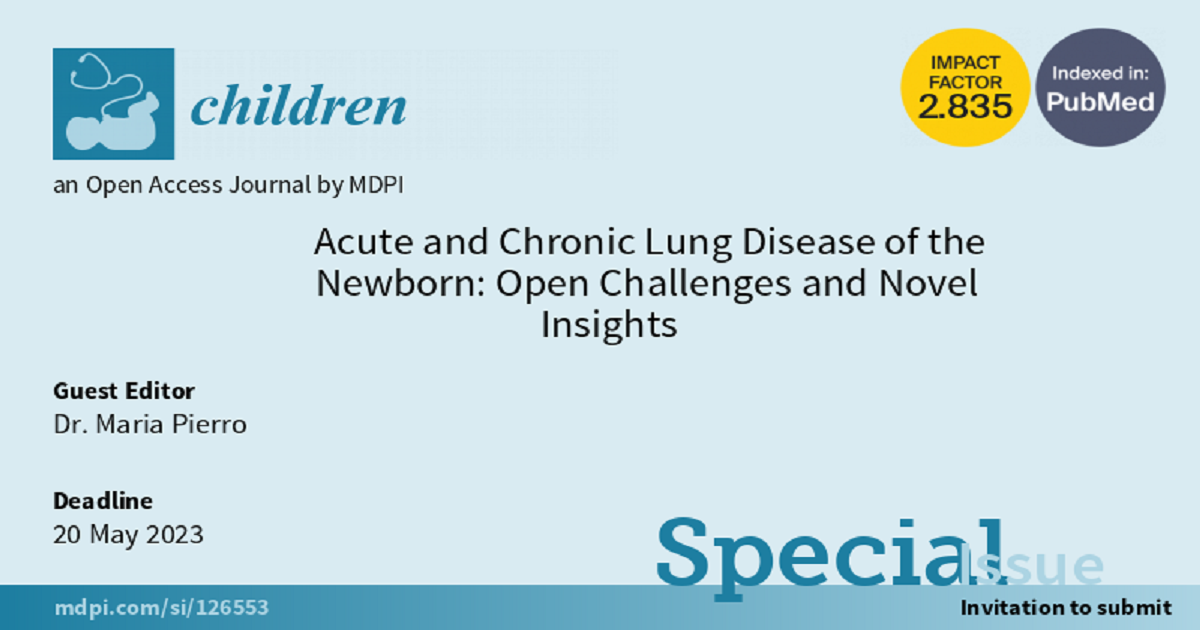Acute and Chronic Lung Disease of the Newborn: Open Challenges and Novel Insights
A special issue of Children (ISSN 2227-9067). This special issue belongs to the section "Pediatric Pulmonary and Sleep Medicine".
Deadline for manuscript submissions: closed (20 May 2023) | Viewed by 10991

Special Issue Editor
Interests: bronchopulmonary dysplasia; neonates; lung ultrasound; mechanical ventilation
Special Issues, Collections and Topics in MDPI journals
Special Issue Information
Dear Colleagues,
Respiratory disorders are the leading cause of admission to neonatal intensive care units, carrying high rates of mortality and morbidity. The definition and characterization of neonatal lung disorders are still a matter of debate. Preclinical and clinical research pertaining to novel ventilation strategies that may decrease the burden of superimposed ventilator-induced lung injury is a continuous field of improvement in neonatology. The point of care evaluation of the respiratory and cardiovascular system is constantly growing and constitutes a potential game-changer when dealing with neonatal lung diseases.
The purpose of this Special Issue is to collect contributions of clinical practice and research on neonatal lung diseases. The volume intends to provide novel insights into neonatal lung diseases, including prevention, diagnosis, monitoring, ventilator strategies and ECMO, novel treatments, supportive strategies and long-term outcomes. In addition to reviews, all types of research papers, from laboratory studies to pro- and retrospective clinical trials, are most welcome. Outstanding case reports with clear added scientific value are also acceptable.
We look forward to potentially collaborating with you and hope to hear back from you soon.
Dr. Maria Pierro
Guest Editor
Manuscript Submission Information
Manuscripts should be submitted online at www.mdpi.com by registering and logging in to this website. Once you are registered, click here to go to the submission form. Manuscripts can be submitted until the deadline. All submissions that pass pre-check are peer-reviewed. Accepted papers will be published continuously in the journal (as soon as accepted) and will be listed together on the special issue website. Research articles, review articles as well as short communications are invited. For planned papers, a title and short abstract (about 250 words) can be sent to the Editorial Office for assessment.
Submitted manuscripts should not have been published previously, nor be under consideration for publication elsewhere (except conference proceedings papers). All manuscripts are thoroughly refereed through a single-blind peer-review process. A guide for authors and other relevant information for submission of manuscripts is available on the Instructions for Authors page. Children is an international peer-reviewed open access monthly journal published by MDPI.
Please visit the Instructions for Authors page before submitting a manuscript. The Article Processing Charge (APC) for publication in this open access journal is 2400 CHF (Swiss Francs). Submitted papers should be well formatted and use good English. Authors may use MDPI's English editing service prior to publication or during author revisions.
Keywords
- acute lung disease of prematurity
- neonatal acute respiratory distress syndrome
- transient tachypnea of the newborn
- chronic lung disease of prematurity
- bronchopulmonary dysplasia
- ventilator-induced lung injury
Benefits of Publishing in a Special Issue
- Ease of navigation: Grouping papers by topic helps scholars navigate broad scope journals more efficiently.
- Greater discoverability: Special Issues support the reach and impact of scientific research. Articles in Special Issues are more discoverable and cited more frequently.
- Expansion of research network: Special Issues facilitate connections among authors, fostering scientific collaborations.
- External promotion: Articles in Special Issues are often promoted through the journal's social media, increasing their visibility.
- Reprint: MDPI Books provides the opportunity to republish successful Special Issues in book format, both online and in print.
Further information on MDPI's Special Issue policies can be found here.






